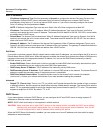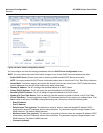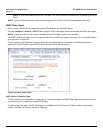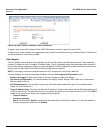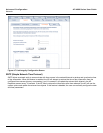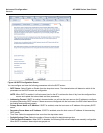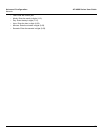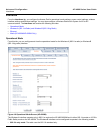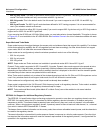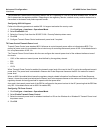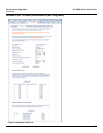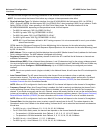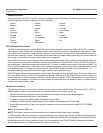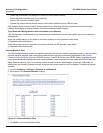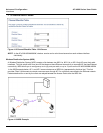
Advanced Configuration AP-4000 Series User Guide
Interfaces
55
• 802.11g only mode: The radio is optimized to communicate with 802.11g devices. This setting will provide the best
results if this radio interface will only communicate with 802.11g devices.
• 802.11b/g mode: This is the default mode. Use this mode if you want to support a mix of 802.11b and 802.11g
devices.
• 802.11g-wifi mode: The 802.11g-wifi mode has been defined for Wi-Fi testing purposes. It is not recommended for
use in your wireless network environment.
In general, you should use either 802.11g only mode (if you want to support 802.11g devices only) or 802.11b/g mode to
support a mix of 802.11b and 802.11g devices.
If you are using the AP-900 and 4.9 Public Safety mode, you must also select a channel bandwidth. This option is shown
in Figure 4-9; it is not available in the AP-4000/4000M. See Available Channels for a list of channels available with each
bandwidth.
Super Mode and Turbo Mode
Super mode improves throughput between the access point and wireless clients that support this capability. For wireless
clients that support this capability the AP will negotiate and treat them accordingly, for other clients that do not support
super mode, the AP will treat them as normal wireless clients.
Super mode can be configured only when the wireless operational mode is one of the following:
• 802.11a only mode
• 802.11g only mode
• 802.11b/g mode
NOTE: Super mode and Turbo mode are not available in operational modes 802.11b and 802.11g-wifi.
Dynamic Turbo mode is supported in 802.11a and 802.11g mode. Dynamic turbo mode supports turbo speeds at twice
the standard 802.11a/g data rates, and also dynamically switches between turbo mode speeds and normal speeds
depending on the wireless client. If turbo mode is enabled, then this is displayed in the web UI and the transmit speeds
and channels pull-down menus are updated with the valid values.
When Turbo mode is enabled, only a subset of the wireless channels on both the 2.4 GHz and 5.0 GHz spectrum can be
used. If any wireless clients do not support turbo mode, the AP will fall back to normal mode.
Turbo mode can be configured only when Super mode has already been enabled.
Super mode is supported in the 2.4 GHz and 5 GHz frequency bands in all regulatory domains. Turbo mode is available
in the 5 GHz frequency band in all regulatory domains except for Japan.
NOTE: Turbo mode and Mesh mode (either Mesh AP or Mesh Portal) can not be enabled on the same interface
simultaneously.
IEEE 802.11d Support for Additional Regulatory Domains
The IEEE 802.11d specification allows conforming equipment to operate in more than one regulatory domain over time.
IEEE 802.11d support allows the AP to broadcast its radio’s regulatory domain information in its beacon and probe
responses to clients. This allows clients to passively learn what country they are in and only transmit in the allowable
spectrum. When a client enters a regulatory domain, it passively scans to learn at least one valid channel, i.e., a channel
upon which it detects IEEE Standard 802.11 frames.
The beacon frame contains information on the country code, the maximum allowable transmit power, and the channels to
be used for the regulatory domain.
The same information is transmitted in probe response frames in response to a client’s probe requests. Once the client
has acquired the information required to meet the transmit requirements of the regulatory domain, it configures itself for
operation in the regulatory domain.



